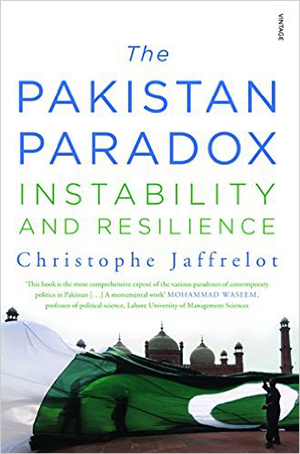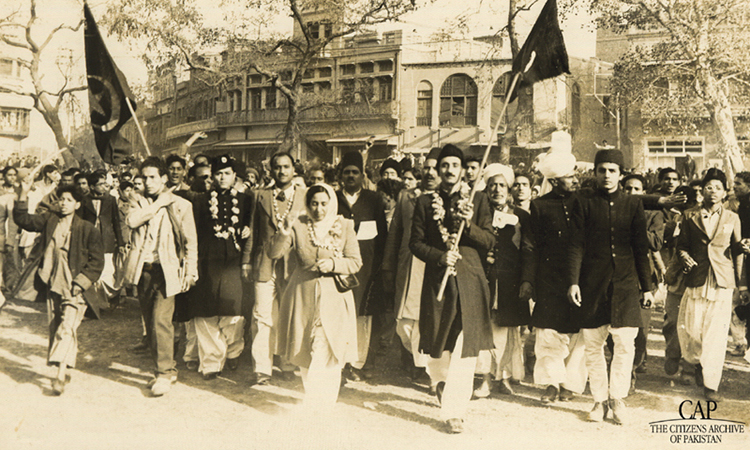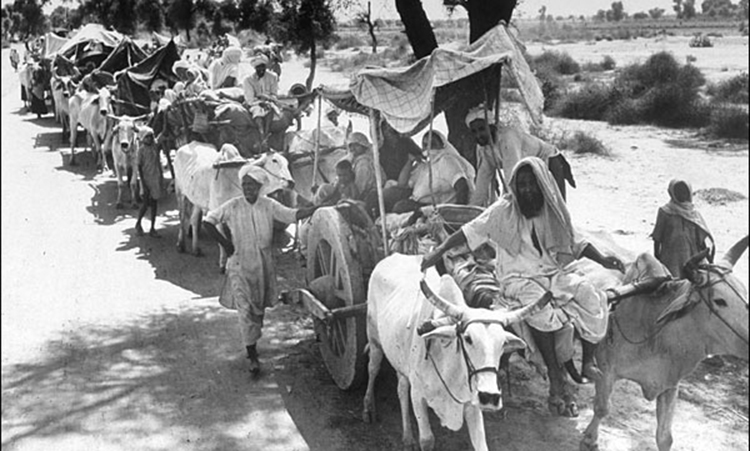Written by: Dr. Ilhan Niaz
Posted on: April 22, 2016 | 
Christophe Jaffrelot
Author: Christophe Jaffrelot.
Translated by: Cynthia Schoch
Title: The Pakistan Paradox: Instability and Resilience.
Publisher: Random House India, Gurgaon.
Year: Original, 2013; this edition; 2015.
Pages: xii + 670.
Price: Pakistani Rupees, 1395.
ISBN: 978-81-8400-574-5
Ilhan Niaz is Assistant Professor of History at the Quaid-i-Azam University, Islamabad, and most recently the author of Old World Empires: Cultures of Power and Governance in Eurasia (New York: Routledge, 2014; India-Pakistan edition by the Oxford University Press).
First, there is a direct correlation between the introduction of representative and democratic reforms during the late-colonial period and the growth of communal antagonism and recourse to religious symbolism and rhetoric as means to mobilize participation in mass politics. This was not something unique to the Muslims of India and found expression in the emergence of Hindu Nationalism and was even reflected in the Indian National Congress’s use of religious symbols via M. K. Gandhi. Muslim modernists like Sir Syed Ahmed Khan had anticipated this problem as to them it was rooted in the fact of a sociopolitical environment that was anti-individualistic. The introduction of democracy and mass politics would, and did, add fuel to communal, sectarian, clan, and caste, chauvinisms and the manipulation of these hatreds proved to be the key to consolidating political power and vote banks. France itself is not a complete stranger to these dark habits of the heart as evidenced by de Tocqueville’s Old Regime and the Revolution and, more recently, by Birnbaum’s The Idea of France.

Second, the democratization of Indian politics in the 1920s and 1930s, combined with the precipitous decline in British imperial fortunes on account of difficult economic conditions after the First World War, the rise of Nazism and the onset of the Second World War, generated a crisis of imperial succession in South Asia. In the past, imperial unifications of India had always given way to warring states, and in the context of the 1940s the recourse of the region to its normal historical condition appeared imminent. In this sense, Pakistan’s nationalism is more authentically South Asian than India’s composite nationalism, which sought to convert the administrative and political imperial unification of the British Raj, without modification, into the basis of a national identity.
Third, Pakistan’s emergence on the world map was different from the independence of many other colonies. Indeed, the territories that became part of Pakistan were never a separate colony that changed status to independent state as happened almost everywhere else that de-colonization took place. The territories that became part of Pakistan had long demanded greater autonomy from the center and, at least in the northwest, had a very different experience of the British Raj than other parts of the Indian empire. When it became evident that their autonomy would not be secure in an independent India ruled by the Congress, they increasingly came over to the idea of complete independence, from New Delhi. As the imperial Brexit from South Asian drew nearer, this trend accelerated. Pakistan was thus carved out of British India as the result of a political process that culminated in the 1946 elections, and the Partition that became inevitable once Congress rejected proposals for a loose confederation. There are very few states that can claim to have come into existence through a conscious exercise in self-determination, and Pakistan is one of them.
It would thus appear that Pakistani nationalism, as expressed in the desire for de jure/de facto independence from New Delhi following the imperial Brexit, was the outcome of the introduction of democratic politics into the psychosocial context of South Asia and this interfaced with the already well-established historical experience of fragmentation upon the end of an imperial unification. This outcome had a loose geographic identification since 1930, and was more precisely worked out as the Raj drew its final breaths. To modify Jaffrelot’s approach in the interests of accuracy, Indian and Pakistani nationalisms both emerged as organized mass movements with strong social support in key constituencies during the 1930s and 1940s. Both nationalisms suffered from internal contradictions but were able to cohere sufficiently to enable the creation of two successor states to the British Raj (India and Pakistan). These successor states have sought to consolidate their original nationalisms and achieved mixed results owing to failures of governance, lack of political leadership, and serious socioeconomic problems. However flawed, India and Pakistan are both national states that espouse passionate, if not particularly empirical, nationalisms.

Aside from Jaffrelot’s central analysis, there are a number of areas where The Pakistan Paradox finds itself in need of greater evidentiary credibility and conceptual clarity. The book is event-oriented and relies for the most part on published secondary sources and on newspapers for its information and analysis. One is hard pressed to find primary sources in the footnotes, and even reports and official documents that are available online, appear to have been ignored or overlooked. While the author does cite a few of Jinnah’s speeches, the lack of field research and documentary rigor betrays nonchalance towards the subject. Given the resources at the author’s disposal and the fact that The Pakistan Paradox is not a philosophical treatise or a theoretical framework, this is a very serious deficiency. Imagine if a Pakistani author were to write a book titled “The French Paradox” and singularly fail to cite primary sources – that individual would be dragged over the coals. Calling Jaffrelot out on this point is essential because far too many Western academic “experts” on Pakistan are able to get away with methodological murder when it comes to their research on the country. Jaffrelot is an India expert whose attempt at authoritative writing about Pakistan is not grounded in the kind of research one should expect. The fact that other reviewers, such as Faisal Devji from St. Antony’s at the University of Oxford, have pronounced the Pakistan Paradox to be “one of the few honest books” they have read on Pakistan indicates that they read very little and that their standard for academic rigor is quite modest.
Then there is the problem of choices faced by Pakistan in its early history. In the aftermath of Partition, Pakistan suffered a proportionately greater upheaval than India, and this led to the political leadership prioritizing state-building over democracy. During this early period (1947-54) Pakistan did not receive large-scale assistance from the outside world and had to rely almost entirely on its own resources to survive communal holocaust, mass-migration, and conflicts with India over trade, currency, water, territory, financial share, and military assets. Under the circumstances, the alternative path, that of prioritizing democracy over state-building, was perhaps not seriously one that could have been taken. After all, you need to have a state before you can convert it into a functioning constitutional democracy.

Reference the “Punjabi” army and the “Punjabi” identity, there are a few observations. First, the Pakistan army, pointed out in The Pakistan Paradox, has been officered principally by non-Punjabis, the Punjabi officers constituting a plurality within the officer corps. Three out of four of Pakistan’s military rulers have been non-Punjabis. At the same time, there is a greater concentration of recruits from the Punjab in the rank-and-file, but this does not seem to affect the professional discipline of the armed forces in any appreciable way. It does not seem that “Punjabiness” is what makes the officer corps of the Pakistan armed services cohere. The answer appears to lie in the pattern of state-building and institutional development with its emphasis on professionalism within a basically apolitical environment. Then coming to the Punjabi identity itself, the construct is highly problematic because the Punjab, like Central Europe or Scandinavia, refers to a broad geographic and cultural zone that is at present divided by national frontiers. This needs more thought.
Pakistan, and pre-1947 Indian Muslims, it is contended by The Pakistan Paradox, have or had a superiority complex and an inferiority complex vis-à-vis India/Hindus, which led them to seek “parity” with the Hindu-majority in British India, and then “parity” between India-Pakistan after 1947. It is not entirely clear as to how one can simultaneously suffer from contradictory complexes triggered by the same stimulus. With regard to the fears of the Muslim modernist elite about what would happen in a united India, in 1990, Khushwant Singh observed that 2376 out of 3300 Indian Administrative Service officers were Brahmins, and, in 2007, the Backward Classes Commission found that 37% of India’s bureaucracy was Brahmin even though Brahmins constitute about 3.5% of India’s population.
Coming to the conclusion of The Pakistan Paradox, one wonders how seriously has the project for a ‘unitary nation state’ been pursued since 1973 with the adoption of a federal constitutional structure? After the 18th Amendment, has this project been put on the back burner or has it genuinely been abandoned? Only time will tell, but reading too much into formal constitutional adaptations is not the best way to analyze a country. Thus, in the context of authoritarian political culture, this can flourish in a democracy just fine. India is a constitutionally stable democracy with arbitrary governance and Pakistan is a constitutionally unstable democracy with arbitrary governance. Even if Pakistan achieves constitutional stability, power will continue to be wielded arbitrarily. On competing conceptions of Islam, this is indeed a major threat and if not handled effectively it could lead to dramatic increase in violence and instability – an increase that goes beyond what Pakistan has experienced thus far.
Overall, Jaffrelot’s Pakistan Paradox is an engaging work that if read critically can provide some food for thought. If history is any guide, paradoxes are inherent in political order and it is their judicious management that is the ultimate test of the worth of a country’s leadership.
You may also like: